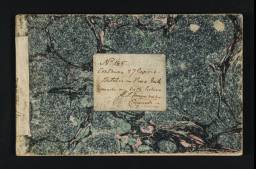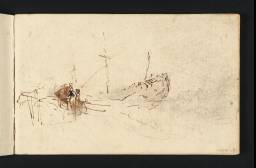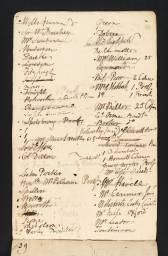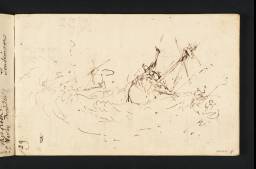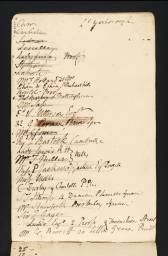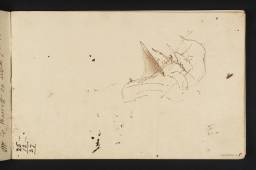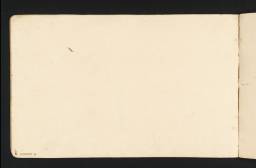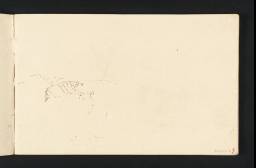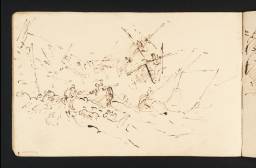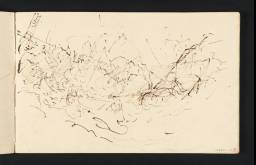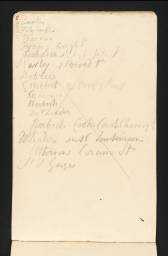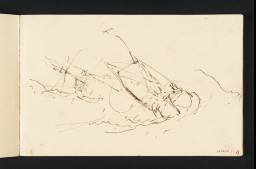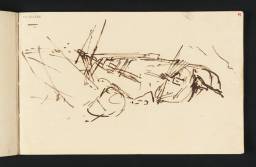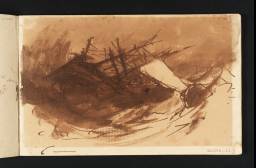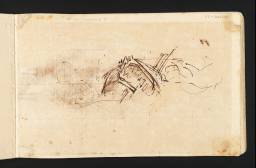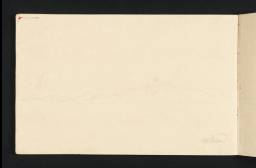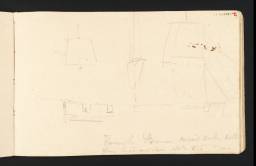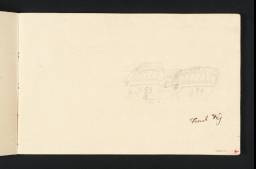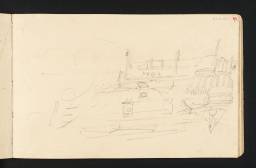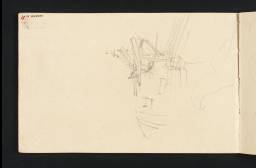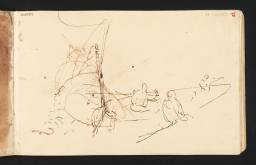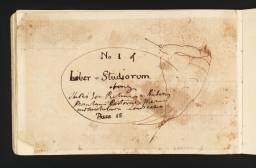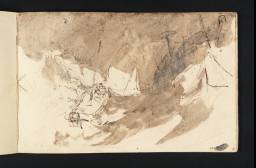Turner Bequest LXXXVII
.
Pocket book, in blue and pink marbled paper covers
26 leaves of cream laid paper made on a single-faced mould
Approximate page size 116 x 184 mm
Made by John Larking at East Malling Mill, Kent, and watermarked with an ornamental fleur-de-lys incorporating the letter L and ‘1801’ or countermarked ‘J LAR...’ Probably bound by William Dickie at 120 The Strand, London
[Four blank leaves made by Van Gelder Zonen, watermarked ‘VGZ’ and with a dancing man on a globe, were added circa 1934]
Inscribed by Turner in ink ‘97. Shipwreck’ on a label on the spine and in pencil ‘Subscriber’s List’ on a label on the front cover
Endorsed by the Executors of the Turner Bequest in ink ‘No. 185 | Contains 27 leaves. Sketches in pen and ink made on both sides’, signed in ink by Henry Scott Trimmer and Charles Turner ‘H.S. Trimmer | C. Turner’ and in pencil by John Prescott Knight and Charles Eastlake ‘JPK’ | ‘C.L.E’. on the label on the front cover. A further endorsement by John Ruskin is recorded by Finberg: ‘A.B. 190. P.R. Pencil studies of Shipwreck, Glaucus & Scylla, &c. Fine. 21’
.
Pocket book, in blue and pink marbled paper covers
26 leaves of cream laid paper made on a single-faced mould
Approximate page size 116 x 184 mm
Made by John Larking at East Malling Mill, Kent, and watermarked with an ornamental fleur-de-lys incorporating the letter L and ‘1801’ or countermarked ‘J LAR...’ Probably bound by William Dickie at 120 The Strand, London
[Four blank leaves made by Van Gelder Zonen, watermarked ‘VGZ’ and with a dancing man on a globe, were added circa 1934]
Inscribed by Turner in ink ‘97. Shipwreck’ on a label on the spine and in pencil ‘Subscriber’s List’ on a label on the front cover
Endorsed by the Executors of the Turner Bequest in ink ‘No. 185 | Contains 27 leaves. Sketches in pen and ink made on both sides’, signed in ink by Henry Scott Trimmer and Charles Turner ‘H.S. Trimmer | C. Turner’ and in pencil by John Prescott Knight and Charles Eastlake ‘JPK’ | ‘C.L.E’. on the label on the front cover. A further endorsement by John Ruskin is recorded by Finberg: ‘A.B. 190. P.R. Pencil studies of Shipwreck, Glaucus & Scylla, &c. Fine. 21’
Accepted by the nation as part of the Turner Bequest 1856
Exhibition history
References
This sketchbook contains various drawings of shipwrecks, vessels in distress and ships including the Victory, and lists of subscribers to Charles Turner’s mezzotint published in 1807 after Turner’s picture The Shipwreck (Tate N00476), which had been exhibited at Turner’s Gallery in 1805.1 Four sketches relate directly to the picture. Another seems to anticipate an earlier oil, Boats Carrying Out Anchors and Cables to Dutch Men of War, in 1665 (Corcoran Gallery of Art, Washington, D.C.), shown at the Royal Academy in 1804.2 There are also two sketches related to The Wreck of a Transport Ship (Fundação Calouste Gulbenkian, Lisbon), of about 1810.3 The ‘Glaucus and Scylla’ mentioned by Ruskin in his endorsement is no longer in the book (and so far untraced) but was presumably related to the unpublished plate of that subject in the Liber Studiorum, the drawing for which (Tate D08170; Turner Bequest CXVIII P) has been dated 1810–15.4 Dated by Finberg to 1805 in the Inventory, the sketchbook must actually have been in use over a longer period beginning as early as 1803. Finberg’s later comments in Sketches and Drawings, that it ‘contains sixteen pages in all’ and ‘the succinct record of an actual shipwreck’, apply to the related Shipwreck (2) sketchbook (Tate D05428–D05445; D40697–D40700; Turner Bequest LXXXVIII).
Boats Carrying out Anchors was the first of an occasional series of historical marines that Turner based on the seventeenth-century Anglo-Dutch wars. A probable sketch for it is on folio 1 (D05376). The picture was bought by Samuel Dobree, who appears in the sketchbook’s list of subscribers to the plate of The Shipwreck. Although Turner’s label for the book and some of its contents might imply a closer link to that picture, and commentators beginning with Finberg have described a number of the drawings as studies for it, only four (folios 7, 9, 13 verso and 17 verso, D05388, D05386, D05427, D05391; Turner Bequest LXXXVII 13, 11, 52, 16) have any real similarity and the lists of subscribers (folios 1 verso, 2 verso and 5 verso, D05377, D05379, D05399; Turner Bequest LXXXVII 2, 4, 24) are the most important points of connection. The mezzotint was published – as the first print after a painting by Turner – on 1 January 1807. The engraver, whose own speculation it was, advertised it in 1805 and it was ready by the middle of the following year. The subscribers listed by the artist are a starry array of noblemen, patrons, collectors and painters young and old. They include Sir John Leicester, who bought the picture in 1806 but exchanged it the next year for The Falls of the Rhine at Schaffhausen (Museum of Fine Arts, Boston),5 apparently because the loss of a family member at sea had made the subject too painful. Turner’s composition studies for The Shipwreck are in the large Calais Pier sketchbook (Tate D04902–D05072; Turner Bequest LXXXI), while the sketches in the present book are slighter and usually of variant compositions. Butlin and Joll, among other commentators, thought them ‘probably from actual wrecks’ without suggesting what these might be. Finberg in Sketches and Drawings, this time mistakenly assigning them to Shipwreck (2), described them as ‘the series of trial compositions ... before the final design of the picture was fixed’.6
How little most of these sketches really impacted on The Shipwreck is shown by the fact that the same commentators generally agreed that its subject was imaginary, or invented in response to the republication in 1804 of William Falconer’s poem The Shipwreck (originally published in 1762), with illustrations by the marine painter William Pocock. In a comprehensive study of shipwreck imagery, Barry Venning has since argued that the picture was inspired by the 1805 wreck of the East Indiaman, The Earl of Abergavenny, off Portland Bill after she was holed in a storm.7 It is not an exact depiction, however, as her masts and rigging were not damaged whereas Turner shows them smashed. In the sketchbook, too, they are often seen in various stages of disintegration. With his long connection with Margate, Turner must also have known of the loss of the Hindoostan, another Indiaman, off the town in 1803. She too had kept her masts intact. Anthony Bailey has drawn attention to another Margate wreck, that of the Mars in 1787.8
Turner need not have witnessed any of these wrecks for them to play on his imagination for the most famous disasters tended to be remembered for years, as was the case with the wreck of yet another Indiaman, the Halsewell, beneath cliffs near Seacombe on the Isle of Purbeck in 1786. Turner referred to her sinking in verses written between 1811 and 1813,9 and Eric Shanes has identified Turner’s watercolour The Loss of an East Indiaman made for Walter Fawkes about 1818 (private collection)10 with the Halsewell.11 As her mainmast, mizzenmast and rigging were cut away two days before she finally broke up, in an attempt to stabilise her, she might be a better candidate for the earlier picture. But Turner surely intended a more universal comment on the horrors of shipwreck, while the sketches in this sketchbook were experiments in dramatic composition which, with the violence of the stormy sea, made the picture appear so compellingly convincing and ‘real’. As Turner realised it, the picture invites readings beyond the realms of illustration or reportage; as a marine display of the Sublime, as Andrew Wilton has argued,12 or a ‘metaphor for the dangers facing Britain, as Napoleon’s armies engulfed the rest of Europe’ in the words of Pieter van der Merwe.13 As the sketchbook also contains sketches of the Victory and perhaps other ships returned from the Battle of Trafalgar, Turner may even have had in mind the terrible storm that beset the surviving fleet during its return voyage.
The Wreck of a Transport Ship for which there are two sketches in the book (folios 4 verso and 5, D05383, D05398; Turner Bequest LXXXVII 8, 23) was painted about 1810 and developed the themes of The Shipwreck. It was bought by the Hon. Charles Pelham, later 1st Earl of Yarborough, whose name also appears among the subscribers to the Shipwreck print. These presumably earlier sketches indicate that Turner cannot have started out to depict the wreck of the Minotaur, on the Haak Sands on 22 December 1810. However, when the picture was exhibited in 1851 this subject was applied retrospectively to its title, its realism having presumably proved so persuasive that it became associated with a true event. A recent suggestion is the sinking, during a sudden storm in Table Bay off Cape Town in November 1799, of the troop ship Sceptre.14 Again, how completely imaginary one thinks Turner’s original idea for the Transport Ship will depend on one’s assessment of the related sketches in this book. They depict a stricken ship that is much larger than in most of the other sketches, in deeper waters, and nothing is known of Turner’s experience at this period to suggest he witnessed such an event. As in The Shipwreck its realism must be a clever illusion, developed through these experimental sketches.
The various sketches of shipwrecks are drawn in ink, mostly with brown or brownish grey wash. Some further sketches from actual shipping, fishing boats or naval vessels including the Victory (folio 27, D05418; Turner Bequest LXXXVII 43) are in pencil. These must have been drawn at Sheerness, Gravesend or on the River Medway and overlap with material in the Nelson sketchbook (Tate D05446–D05490; D40701–D40705; D41427; Turner Bequest LXXXIX) collected when Turner visited the Victory and the returned Trafalgar fleet around Christmas 1805. One (folio 27 verso, D05419; Turner Bequest LXXXVII 44) is inscribed ‘Gravesend’ and sketches inside the back cover (D40696), if of the hospital ship Argonaut, will have been made on the Medway where she was moored. The most tantalising aspect of the book is a double-page sketch of coastline seen from the sea, labelled ‘Flushing’ and ‘Ostend’ (folios 10 verso–11, D05405–D05406; Turner Bequest LXXXVII 30–31). Turner is not otherwise known to have crossed the Channel or North Sea within sight of the Belgian or Dutch coast between 1803 and 1810, and wartime conditions can hardly have been conducive to such a trip. The missing ‘Glaucus and Scylla’ is also a mystery, although Turner was using this book at the time when he was working on the Liber Studiorum and there may have been some connection in his mind between scenes of wreck and the coastal setting of Glaucus’s pursuit of the Nereid Scylla. Scylla, a daughter of Typhon, was transformed into rocks between Italy and Sicily that were famously dangerous to shipping.15 Charles Turner, engraver of The Shipwreck, also worked on the Liber and Turner’s friend William Frederick Wells, a major subscriber to the print, helped to instigate the project. A design for its title page is on folio 14 verso (D05385; Turner Bequest LXXXVII 10).
Gillian Forrester, Turner’s ‘Drawing Book’: The Liber Studiorum, exhibition catalogue, Tate Gallery, London 1996, p.135.
Barry Venning, ‘A Macabre Connoisseurship: Turner, Byron and the Apprehension of Shipwreck Subjects in Early Nineteenth-Century England’, Art History, vol.8, no.3, September 1985, pp.303–19.
Devonshire Coast No.1 sketchbook, folio 56 verso (Tate D08474 ); see also Andrew Wilton and Rosalind Mallord Turner, Painting and Poetry: Turner’s ‘Verse Book’ and his Work of 1804–1812, exhibition catalogue, Tate Gallery, London 1990, p.171.
Eric Shanes, Turner’s Watercolour Explorations 1810–1842, exhibition catalogue, Tate Gallery, London 1997, pp.34–5.
Andrew Wilton, Turner and the Sublime, exhibition catalogue, Art Gallery of Ontario, Toronto 1980, pp.46–7, 145.
Technical notes
How to cite
David Blayney Brown, ‘Shipwreck (1) sketchbook c.1803–10’, sketchbook, December 2005, in David Blayney Brown (ed.), J.M.W. Turner: Sketchbooks, Drawings and Watercolours, Tate Research Publication, December 2012, https://www

